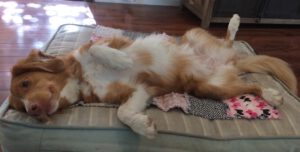5 Steps to Successful Canine Massage

You may have read the title of this blogpost and thought, “How can canine massage not be successful?” It is possible. Have you ever had a massage that you did not enjoy? As humans, we may not want to tell the massage therapist that we are not enjoying it. Maybe we do not want to hurt their feelings, or we do not want to seem unappreciative. So we endure the massage and either do not return the next time, or return with a feeling of aversion. Yet, dogs often will tell you that they are not enjoying the massage. And that’s a good thing. It helps you understand what they might need to feel more comfortable. Here are a few ways to help ensure a successful canine massage.
1. Set the Mood. Soft music is relaxing. I like to use the Through a Dog’s Ear CD, or I find soothing music for free on You Tube. Find something that feels calming to you and it will likely be calming for your dog. Aromatherapy can also help your dog relax. Effusing essential oils like chamomile or lavender can be very comforting to both you and your dog. In addition, give your dog something pleasing to lie on, whether it is his bed, or a favorite blanket.
2. Control the Environment. Find a quiet spot that is also a restful one for your dog. For example, if there is a quiet room in your house, but you and your dog do not typically go into that room, this may not be a relaxing place for your dog. Utilize a space where he normally rests or sleeps and remove distractions that may interrupt the massage. Give the massage during a quiet part of the day. Late afternoon and early evening when the kids are coming home from school or after you just arrived home from work are not ideal times for your dog to feel calm. Mid-morning or later in the evening before bedtime could prove opportune times for a relaxing moment.
3. Be Patient. Your dog may not be used to slow and gentle touching from you. Maybe he is more familiar with a lot of play or energetic interaction with you. He may try to lick your face, offer his paw, or initiate play because you are sitting on the ground with him. This new experience could even be stressful because it is unusual and different for him. Sit quietly to encourage him to do the same. Do not engage in eye contact, which can be exciting. Take deep breaths and be calm yourself. Allow your dog to settle without pushing him into a Down or telling him to relax. I don’t know your experience, but when someone tells me to relax, it has the opposite effect!!
4. Be Gentle. I frequently see videos online of people giving vigorous massages to their dogs and sometimes even tapping them across their noses and faces! This is not relaxing. Think of how you would want to be touched. Can you relax while your body is being pushed energetically about or while your nose and face are being suddenly tapped? Slow down, take a breath, and be gentle. Start with the parts your dog enjoys having touched. For some, this might be the forehead or ears. For others, it may be the chest or neck. Stay in these areas until you feel your dog relaxing. Then you can move onto the shoulders or legs as your dog is comfortable.
5. Allow Your Dog to Walk Away. This is your dog’s way of saying no. Maybe the massage is uncomfortable or painful. Or maybe it has been several minutes and he’s all done. This is OK. You may try to call him back once, but if he doesn’t want to return, that’s OK. You can try again the next day and maybe he will be more comfortable. It may take him a few sessions until he can have a complete massage. Again, be patient. When he starts to feel the positive effect of the massage, it is likely he will want to experience it again. Allowing him to walk away when he wants will give you information about what he is feeling and will help you be more aware of what he needs the next time.
Keep these 5 steps in mind and you are on your way to a successful massage. Interested in having someone else give the canine massage for you? I am a certified canine massage therapist and I can do that! Please visit my website page on massage for information and rates.
Lynn Webb, M.A., KPA CTP, CTMT


